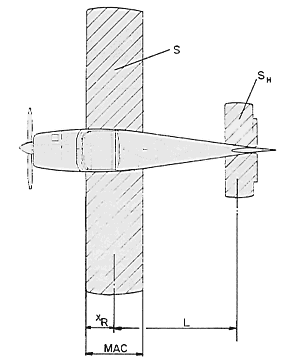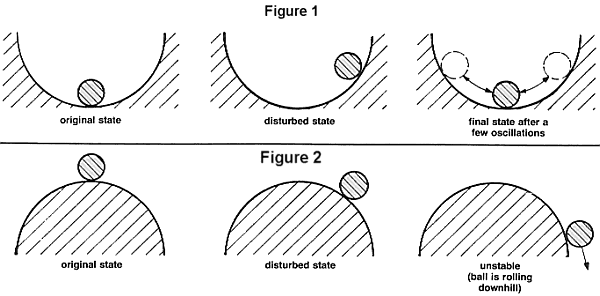By Chris Heintz, P. Eng.
[This article is part of a series where aeronautical engineer Chris Heintz discusses light aircraft design and construction.]
Stability: A system is stable when it comes back to its original state after it was submitted to an external disturbance. The classic example is a ball in a bowl (see Figure 1). In an unstable system, a disturbance will produce an ever-increasing change from the original state; the corresponding classic example is a ball on a hilltop (see Figure 2). The new state is at rest but different from the original. Example: A ball on the pool table (see Figure 3).
Indifferent stability is the boundary between stable and unstable. This is easily imagined when we see the ball in the bowl. Then visualize the bowl opening more and more, becoming a flat surface and then the original inside becoming the outside of the bowl (see Figure 4). When applied to an aircraft, the concept of stability means: At a given power setting, the aircraft has been trimmed to a certain speed when the pitch control is left untouched. If a disturbance occurs (a gust or a short push or pull on the control), the aircraft is said to be stable if it returns to its original speed (this is associated to the aircraft's nose position with respect to the horizon). It is said to be unstable if the disturbance produces an ever-increasing amplitude of the speed until the aircraft hits the ground or stalls. It is said to be indifferent if the speed stabilizes at a different value than the original trim speed.
Most of the time and in all three cases there are usually several oscillations. The oscillations have usually a short period (say less than five seconds). For the pilot, what does it mean if his aircraft is not stable?. All that is required is to take hold of the pitch control and bring the speed back to the trim speed. This is obviously not a dangerous situation, although it may be quite tiring on a long cross-country flight if the aircraft does not fly "hands off." We simply have to "fly it" all the time. Note the above applies to VFR flying; an IFR unstable aircraft is dangerous because the pilot's workload becomes too much when we have to concentrate on the instruments as well as keeping the speed steady.
From a design standpoint, the graph (see Figure 5) allows us to design a stable aircraft. XR is the most rearward position of the center of gravity where the aircraft is still stable. If X, which is the actual center of gravity position, is smaller than XR, the aircraft is stable and can be flown hands off.
Because an aircraft flies mainly with its wing, the wing leading edge is the reference for measuring X and XR (see Figure 6). The two lines in the diagram represent the following formula:
XR = .17 + .37 SH/S x L/MAC - Low Wing
XR = .19 + .37 SH/S x L/MAC - High Wing
where:
SH horizontal tail area
S wing area
L distance from DR to horizontal tail
center of lift
MAC wing mean aerodynamic chord
 (SH x L
is sometimes called horizontal tail volume because it is the
tail surface times another dimension.)
(SH x L
is sometimes called horizontal tail volume because it is the
tail surface times another dimension.)
Because L is a function of XR, a trial and error process is necessary to solve the equation. We will not go into those details as it is quite all right to measure L from the wings' center of lift to the horizontal tail's center of lift, which are both very close to the quarter chord point.
The formula takes into account that a high wing aircraft, due to the pendulum effect, is slightly more stable than a low wing aircraft, all other factors being the same.
It is also interesting to know that the formula applies to classic as well as canard aircraft and even to flying wings (tailless aircraft), although both L and SH are equal to zero.
To my knowledge, it has no theoretic foundation, it is based strictly on statistics and is surprisingly accurate. I would be interested to hear from a stability specialist when he has discovered the theory behind it.




